These photos show some examples of Paul Mann's work that were on display at the SHS Open Day on 30 September 2006.
Sherington Historical Society regrets that we are unable to advise on the likely value of paintings by any of the artists featured on our Website. We would respectfully suggest that owners contact a local art dealer or auction house.
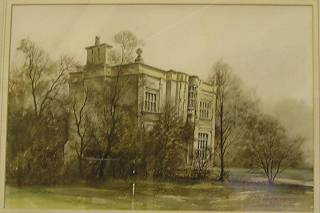 |
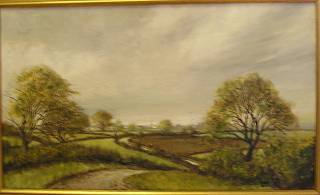 |
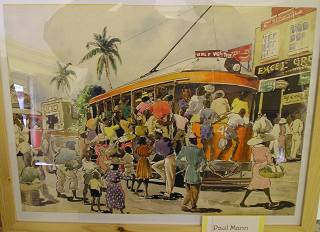 |
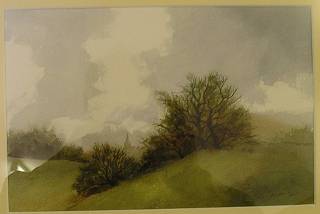 |
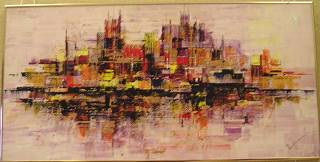 |
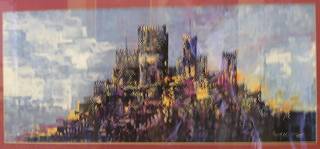 |
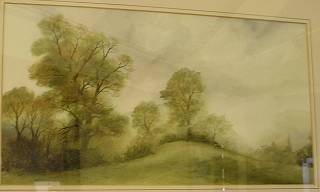 |
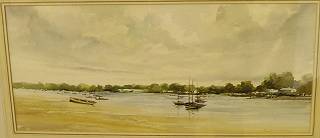 |
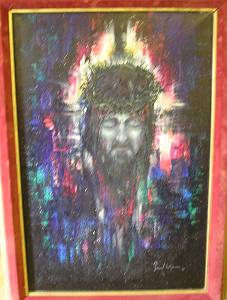 |
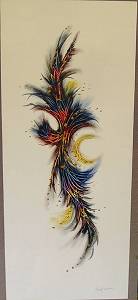 | 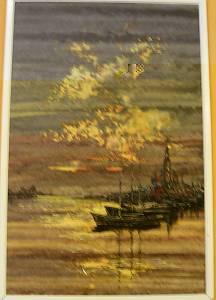 |
We are grateful to Julia Wilson for providing the following biography of her father, Paul Mann.
PAUL MANN FRSA
1907 - 1994
Paul Mann was one of three children born into very humble circumstances in Kettering on 16th February, 1907. At the time of Paul's birth his father was a railway engine cleaner who later emigrated to Canada in search of a fortune - which he never made. Paul was educated at the Central School in Kettering, a forerunner of the technical colleges. Although he always aspired to be an artist he mainly studied woodwork and technical drawing with the intention of becoming a woodwork teacher or technical draughtsman. He was a keen sportsman, playing rugby for Kettering Town team, an excellent swimmer and a low handicap golfer. As a boy he sang in the choir of St. Mary's Anglo-Catholic church in Kettering and was an enthusiastic Boy Scout, becoming an early King's Scout in the reign of George V.
Paul's first job was as a draughtsman working in the local blast furnaces. He married his first wife, Vera, with whom he had two sons and, in 1936, they moved to Watford where he took a job as a sales rep. with paper manufacturers, John Dickinson. During this time he submitted some drawings to 'Railway' magazine. These subsequently resulted in his being offered the position of Art Editor on the magazine. Through this, and his early connections in Kettering, he became a friend of W. Bassett-Lowke, founder of the famous model making company, with whom he later co-operated on several publications in the Puffin series, such as `Marvellous Models & Models to Make'.
Just before the outbreak of WWII he moved to Stanmore so that he could commute more easily to the 'Railway' offices in Cricklewood. One of his monthly tasks was to paint a removable plate showing the livery of one of the numerous railway companies that existed before nationalisation. He also drew some of the exquisite cutaway drawings that appeared as centre-folds in the 'Eagle' comic, and he wrote and illustrated 'How to Draw Locomotives' and 'How to Draw Rolling Stock' that appeared very successfully in the Studio series.
When the war started he was, quite understandably, assigned to the Royal Engineers where he trained in the use of explosives and eventually became a Master Sergeant. Early on in the war he was posted to Halifax, Nova Scotia, then via New York and New Orleans to Jamaica where he joined forces with the Canadian Royal Engineers. No one quite knows why! He used to claim that one of his first tasks was to blow up the alligators in the officers' swimming pool! What is known is that this serendipitous posting allowed him the time to develop as the artist he had always wanted to be. A number of his watercolour sketches still exist from his time on the island.
Returning to England towards the end of the war he moved to Harrow and started to make a (bare) living, mainly as a freelance commercial artist — doing anything he could to make ends meet. He designed brochures and exhibition stands, posters for the Belgian railways and constructed dioramas for the Commonwealth Institute; meanwhile painting in watercolours and oils more for pleasure than for profit.
The most significant event of his painting career came after he had been asked by an old friend in Kettering to produce designs that could be printed on leather with cellulose paint. This never really came to anything. The paint fell off! However, it left Paul with several cans of cellulose and being the creative artist he was, he set about mastering its use as an artist's medium. Although he continued to paint watercolours for the rest of his life, his favourite and most challenging medium was always Cellon, a cellulose paint manufactured by Courtaulds who continued to support him with free paint long after the first cans were exhausted. He also received long term support from Kodak Ltd. after he found that the baryta-clay coated paper used for photographic prints was the ideal material for use with cellulose, its smooth, reflective surface contributing to the luminosity of many of his works.
In the early Fifties he and Vera divorced and he married Ginny who shared his love of art and particularly of music. Ginny gave him two more children, a boy and a girl. During their very happy marriage they lived in Hatch End, a small town with a high proportion of residents who were involved with the theatre, radio and TV. They became good friends with the actor and broadcaster Sam Costa and a number of other celebrities in the area who appreciated Paul's cellulose paintings and bought enough to start building his reputation as a painter.
In 1966, while the children were still very young, Ginny was tragically killed in a road accident. A year later Paul married his third wife Olga, who had lost her first husband in the war. Olga became a mother to the children and continued to support Paul's artistic ambitions, later having a significant effect on his painting style. By this time one of Paul's elder sons had moved to Bedfordshire and this prompted Paul and Olga to move to Sherington where they spent several happy years at Calgary House, next to the parish church. Later they moved to a large farmhouse in Skillington, near Grantham and then, as they grew older, to a more manageable bungalow in Colsterworth. In his 70s Paul suffered a stroke which temporarily affected his 'painting arm' but he completely recovered from this and went on painting, as prolifically as ever, well into his 80s. Finally he suffered a series of minor but progressive strokes and he and Olga moved back to Milton Keynes, buying a flat in sheltered accommodation at Oaktree Court where their family were able to provide support in their final years. Dying several years before Olga, Paul left his children a legacy of several hundred paintings, in watercolour and cellulose, a few of which can be seen in this exhibition.
24 .9. 2006 Richard Mann
Paul Mann - Biographical Notes
Kettering was the birthplace of Paul Mann in 1907 where he had a very happy childhood until the 1914 – 1918 war.. The war years were grim and the family was so poor that anything other than the bard necessities was beyond them. He managed to improvise art materials from starch, hops and burnt sticks for charcoal, but had to abandon the idea of going to Bedford School and went to a state school until the age of 16. His first job was in the office of a leather merchant, going to art classes in the evenings. However he was sacked from this job through using the brown wrapping paper and charts for drawing with. Since some of the drawings were caricatures of the boss it didn’t go down too well. Next he worked on maintenance drawings for a blast furnace, but with the 1926 strike everything went haywire and he had to discontinue going to Wellingborough Art School. He married for the first time in 1930 and began work as a sketch artist in a printing firm. Later he became very well known as a freelance illustrator. 1942 was the year that he joined the army and also his first book was published “ How to Draw Locomotives “, it sold over 100,000 copies. In the army he served with the Royal Engineers and spent all of his career as an artist. He went to the U.S.A. and the West Indies which is where he began painting seriously. After being demobbed he decided to become a painter at the age of 39. This may have been a factor in the breaking up of his marriage. At the age of 50 he explored the possibilities of cellulose as an art medium and became a leading authority on this difficult medium.
C.L. 23.8.2006